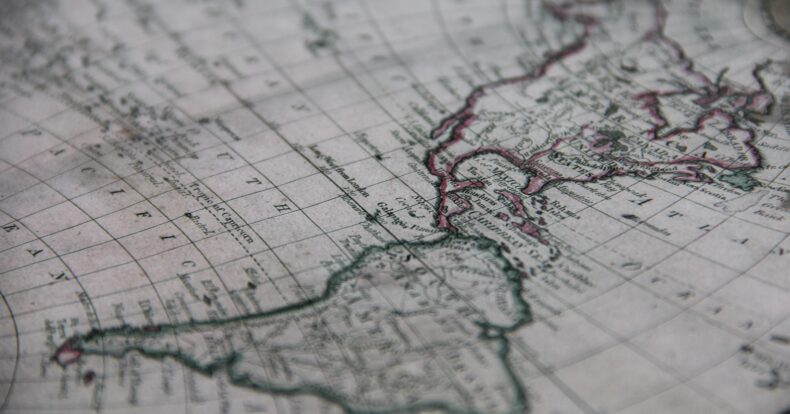Introduction of the first human groups in the current territory of Costa Rica (12 000-1000 BC).

When the Spaniards arrived in America in 1492 -and in Costa Rica in 1502- they found that there were native populations that were settled; therefore, where did these human groups come from, when did they arrive, who were the first to inhabit centuries before the arrival of the Spaniards in the current territory known today as Costa Rica, and how was the process of cultural consolidation of these first inhabitants?
In the same way, it should be taken into account that, for these ancient times, the name of the current country -Costa Rica- did not exist to refer to this territory, nor did it have political borders like today’s, but rather they were mainly cultural borders. In the case of Costa Rica, there was predominantly influence from the Mesoamerican and intermediate cultural regions.
Introduction of the first human groups in the current territory of Costa Rica (12 000-1000 BC).
When the Spaniards arrived in America in 1492 -and in Costa Rica in 1502- they found that there were native populations that were settled; therefore, where did these human groups come from, when did they arrive, who were the first to inhabit centuries before the arrival of the Spaniards in the current territory known today as Costa Rica, and how was the process of cultural consolidation of these first inhabitants?
In the same way, it should be taken into account that, for these ancient times, the name of the current country -Costa Rica- did not exist to refer to this territory, nor did it have political borders like today’s, but rather they were mainly cultural borders. In the case of Costa Rica, there was predominantly influence from the Mesoamerican and intermediate cultural regions.
A complex process
Before commenting on the origin of these groups, it is important to make the following clear: history is not a linear or static matter, where changes occur from one day to the next; therefore, it can be stated that history consists of a series of processes that are made up of cultural structures, such as religion, economy, trade, arts, politics, architecture, agriculture, cosmovision, scientific knowledge, among others.
According to the above, we can understand that this introduction of the first human groups in the current territory that today we call “America” is a process, and that it was not a single introduction, but several introductions through more than one way and motivations; and not from a single group, but from several human groups, where there was also a process not only of transition or geographical transfer, but also of adaptation to the diverse environments that make up the American landmass.
Likewise, the different cultures adapted and consolidated as they developed in subsistence activities in the regions of the continent. In other words, the native civilizations that the Spanish invaders saw were the result of thousands of years of development of older societies. Having understood these processes as complex and not episodic, we will now address in general the origin of the first settlements in the continent, since to understand this process -specifically in Costa Rica- we must understand the generalized process in the entire American land mass.
The origin of these first human groups on the continent
When the Spaniards arrived to the American continent, and realized that they had not arrived to India, as Christopher Columbus thought, some voices were pronounced that wanted to give an explanation of why this territory, previously unknown to the Europeans, was populated by human beings of whom the Bible makes no mention, since for them this book and the religion of Christianity was very important to understand all aspects of daily life and its explanations. Meanwhile, people like Juan Ginés de Sepúlveda, affirmed that these indigenous civilizations should not be considered as human beings because they were not mentioned in the Judeo-Christian Holy Scriptures (1).
However, Pope Leo X, in 1512, argued contradicting the previous statement, since all mankind descended from Adam and Eve, these peoples in America had the same origin as the rest of humanity, so to explain their stay in this territory, a possible justification was the fact that they were forced to migrate for some reason to reach the new continent (2).
Some claimed that the indigenous people in America were descendants of some tribe of Israel, the English, the French, the Romans, the Greeks, and it was even claimed that they came from Atlantis. However, people like the Jesuit José de Acosta in 1590 and the Englishman Edward Brerewood in 1614 raised the possibility that this migration was through some connection between Asia and America, where a kind of bridge facilitated the process of transition from one territory to the other by these nomadic groups.
According to the above, the most accepted theory is that the first human beings originated in Africa around 100,000 years ago. And approximately between 40 000 and 20 000 years ago, human groups coming from the northeastern end of the Asian continent began to enter from Siberia to the current territory called Alaska, since both territories were united by a land mass, which was called Beringia, from the end of the last glaciation (the so-called Wisconsin glaciation). It is with this that the first humans in this new territory began to domesticate both native plants and animals, practically from scratch.
It is from this process of adaptation of the environment, nature and geography that these societies were consolidated in organizational aspects of social, economic, political and religious type. These adaptations developed into societies with increasingly complex structures.
With respect to the organizational distribution of the territory, once they arrived in Alaska and while the Bering Strait was melting, these groups were gradually distributed along the continent through the route on the northwest coast of the Pacific, where the first humans began to practice fishing and hunting, since the autonomous production of food was not yet of their knowledge, and whose subsistence activities were not too specialized. In addition, the distribution of labor in daily life was not limited to gender or age roles.
Arrival and specific settlement in Costa Rica
The first humans to occupy the current territory of Costa Rica were nomads who traveled in small family bands, dating between 12,000 and 8,000 BC. They inhabited tropical species such as mastodons, giant sloths, horses and camelids, and the landscape was characterized by mountains and tropical forests (3), which also its isthmic geographical position and climates favored the development process for these people who gradually settled (4).
In short, it was not until around 8000 and 4000 B.C. that these populations adopted sedentarization and food domestication; likewise, they gradually selected both the flora and fauna that could be consumed, and also adapted diverse mechanisms such as hunting instruments and the construction of rafts to move along water routes.
With agriculture as a practice that was gradually developing, dating from approximately 4000 to 1000 B.C., these populations became specialized in the agricultural products they planted, such as yucca, sweet potato, corn and beans; however, grains were the majority in the Northern Pacific and Central Valley regions, while in the Caribbean slope zone, tuber cultivation predominated.
As an additional fact, it is important to mention that these settled groups came from the Chibcha family, which consisted of a mosaic of cultures along the geographical extension from Nicaragua to Ecuador. Therefore, in Costa Rica there was a great influence of these cultures and languages for being part historically speaking of this whole region dominated by the Chibcha families.
Costa Rica was part of a region of passage for nomadic groups that traveled from the north to the south, some of these groups eventually settled in part of the region that is now Central America, Colombia, Venezuela and Ecuador. Costa Rica also had its own development of human settlements, but at the same time interacted with other neighboring groups located in all cardinal points. This intermediate region shared certain similar cultural characteristics, such as linguistic and genetic aspects.
In conclusion, it can be affirmed that these first settlements of the first people to arrive in Costa Rica were due to factors such as the productive richness of the soil, the variety of climates and reliefs, the presence of both flora and fauna for human consumption, and the biological need to settle in order to consolidate societies in a given territory, perfecting survival mechanisms such as hunting and gathering tools and -later- agriculture, including the construction of houses, which is part of a series of repercussions that come with settling in a territory.
All of the above within a framework of understanding that it did not happen overnight, but was a gradual process until culturally complex societies were generated. Finally, the period between approximately 12,000 and 1,000 B.C. covers the processes from the arrival of nomadic bands to the gradual adaptation of agriculture and sedentarization.
- Juan Carlos Solórzano Fonseca, América Antigua. Los pueblos precolombinos desde el poblamiento original hasta los inicios de la conquista española (San José: Editorial de la Universidad de Costa Rica, 2011), 51.
- Ibíd
- Iván Molina Jiménez y Steven Palmer, Historia de Costa Rica (San José: Editorial de la Universidad de Costa Rica, 2017), 1-2.
- Óscar Fonseca Zamora, Historia antigua de Costa Rica: surgimiento y caracterización de la primera civilización costarricense (San José: Editorial de la Universidad de Costa Rica, 1996), 33-35.
- Molina y Palmer, Historia de Costa Rica, 2-3.
- Fonseca Zamora, Historia antigua de Costa Rica…, 23-28.
Navigate articles




